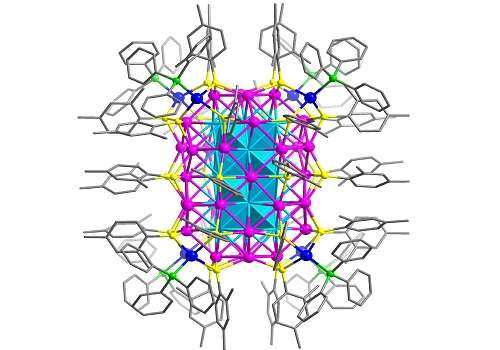Thinking outside nanocluster's box

Research at King Abdullah University of Science and Technology (KAUST), Saudi Arabia, finds that silver atoms can be crafted into a box-shaped nanocluster by careful selection of ligand molecules.
When small numbers of metal atoms cluster, they can behave more like molecules or superatoms, with electrons shared among all of the atomic nuclei. These nanoclusters exhibit novel chemical, electrical and optical behavior that may lead to the development of new catalysts, opto-electronic structures and other components for nanotechnology.
Researchers at KAUST have made significant advances in controlling the structure and function of nanoclusters to produce a unique box-shaped cluster of 67 silver atoms with a central core of 23 atoms inside a 44 atom outer box.
"We are trying to figure out the rules that control how these clusters form," said Osman Bakr, KAUST associate professor of material science and engineering and the leader of the research team.
The box shape is very rare, and so demonstrating how to make boxes and rods will bring a new level of control to nanocluster synthesis. The key to controlling the assembly of the nanoclusters lies in the choice of organic (carbon-based) chemical groups called ligands that surround the metal atoms.
Bakr noted that the researchers can explore different shapes of clusters by experimenting with the structure of the ligands. They found that a mixture of phosphorus-containing groups called phosphines and sulfur-containing thiols allowed the unusual box shape of the silver atoms to assemble within the ligand shell.
"When we change the shape of these clusters, we get interesting new properties," Bakr said. He hopes that his team's exploration of nanocluster chemistry may show the way to develop new catalysts to accelerate chemical reactions that will have use in industry and perhaps also in pharmaceutical science.
A main factor of interest in producing box-shaped clusters is that it reveals how to introduce "directionality" into the clusters. Bakr explained that this is the difficult challenge of making clusters that are structured differently in different directions, unlike the more easily produced perfectly symmetrical forms.
Another innovation the KAUST group is developing that is represented by this latest work is the use of silver atoms in nanoclusters rather than the more commonly used gold.
"Silver is about one tenth the cost of gold, an economic factor that could be very significant when applying these innovations to possible nanotechnology," Bakr pointed out.
The KAUST researchers previously showed that careful control of cluster design can generate silver clusters that behave much the same as gold ones, and now they are crafting silver clusters into a greater variety of shapes.
More information: Mohammad J. Alhilaly et al. [Ag(SPhMe)(PPh)]: Synthesis, Total Structure, and Optical Properties of a Large Box-Shaped Silver Nanocluster, Journal of the American Chemical Society (2016). DOI: 10.1021/jacs.6b09007
Journal information: Journal of the American Chemical Society




















